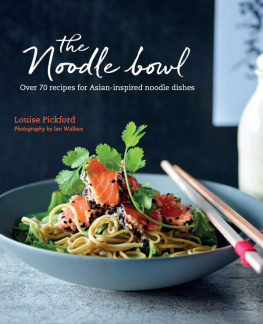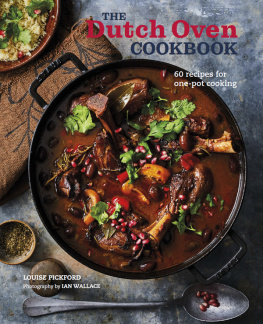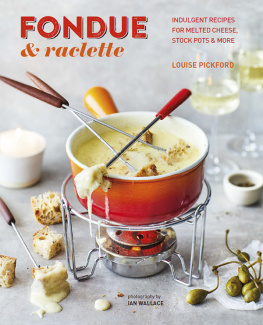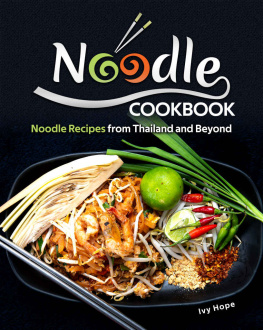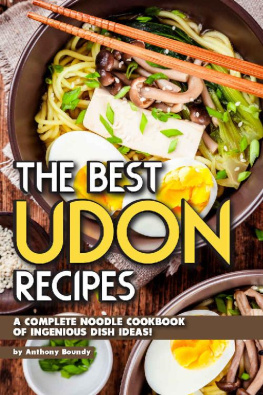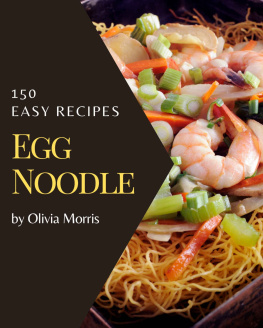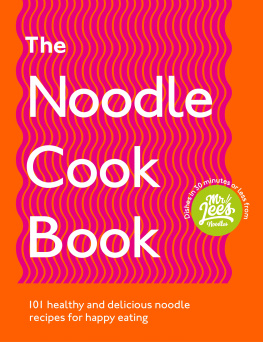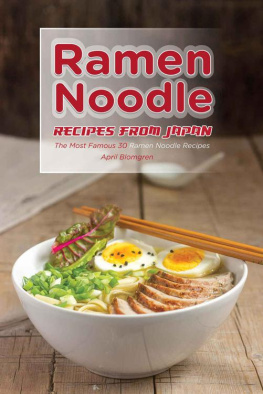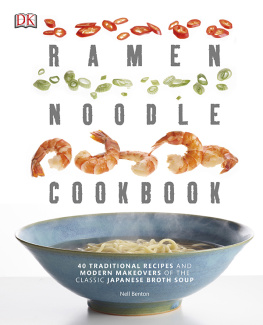The
Noodle bowl


The
Noodle bowl
Over 70 recipes for Asian-inspired noodle dishes
Louise Pickford
photography by Ian Wallace

Senior Designer Sonya Nathoo
Commissioning Editor Stephanie Milner
Production Controller Mai-ling Collyer
Art Director Leslie Harrington
Editorial Director Julia Charles
Publisher Cindy Richards
Food Stylist Louise Pickford
Prop Stylist Tony Hutchinson
Indexer Vanessa Bird
First published in 2015
This revised edition published in 2020
by Ryland Peters & Small
2021 Jockeys Fields
London WCiR 4BW
and
341 East 116th Street
New York NY 10029
www.rylandpeters.com
Text Louise Pickford 2015, 2020
Design and photographs Ryland Peters & Small 2015, 2020
ISBN: 978-1-78879-235-6
E-ISBN: 978-1-78879-307-0
10 9 8 7 6 5 4 3 2 1
The authors moral rights have been asserted. All rights reserved. No part of this publication may be reproduced, stored in a retrieval system, or transmitted in any form or by any means, electronic, mechanical, photocopying or otherwise, without the prior permission of the publisher.
Printed and bound in China.
CIP data from the Library of Congress has been applied for. A CIP record for this book is available from the British Library.
Notes
Both British (metric) and American (imperial plus US cups) are included in these recipes for your convenience; however it is important to work with one set of measurements and not alternate between the two within a recipe.
All spoon measurements are level unless otherwise specified.
All eggs are medium (UK) or large (US), unless specified as large, in which case US extra large should be used. Uncooked or partially cooked eggs should not be served to the very old, frail, young children, pregnant women or those with compromised immune systems.
Ovens should be preheated to the specified temperatures. We recommend using an oven thermometer. If using a fan-assisted oven, adjust temperatures according to the manufacturers instructions.
When a recipe calls for the grated zest of citrus fruit, buy unwaxed fruit and wash well before using. If you can only find treated fruit, scrub well in warm soapy water before using.
To sterilize preserving jars, wash them in hot, soapy water and rinse in boiling water. Place in a large saucepan and cover with hot water. With the saucepan lid on, bring the water to a boil and continue boiling for 15 minutes. Turn off the heat and leave the jars in the hot water until just before they are to be filled. Invert the jars onto a clean dish towel to dry. Sterilize the lids for 5 minutes, by boiling or according to the manufacturers instructions. Jars should be filled and sealed while they are still hot.

Contents

Korean chilled noodles with egg

Balachung delicious deep-fried crispy shallots from Myanmar

Delicious fresh egg noodles served hot, straight from the wok
Asian noodles in all their glorious forms
This book celebrates what I feel is best about noodles, noodle dishes and their origins. It doesnt claim to be a noodle bible, more a close look at the variety and versatility of this wonderful food. I have a passion for everything noodle and I hope I can share my enthusiasm with the following collection of recipes.

Although I had travelled to Asia and the Far East before, it was my move to Sydney in 2000 that introduced me to a far wider range of cuisines from those countries. Australia with its multicultural society is home to a large population of Asian immigrants including Chinese, Japanese, Thai, Vietnamese, Cambodian, Laotian, Korean, Indonesian and more besides. You dont have to travel far in Sydney to find an ethnic restaurant and even in our local suburb we had two Thai restaurants, a Japanese, a Chinese, a Vietnamese caf, two Indonesian restaurants and a South-east Asian noodle bar.
Living in that region for 13 years enabled me to experience a whole gambit of new and exciting dishes. Not only did I discover foods with flavours that literally explode in your mouth (not just the chillies/chiles), I found a lighter, healthier and more balanced diet: fresh vibrant salads, pungent aromatic broths packed with crisp raw vegetables and fragrant herbs; stir-fried vegetables and meat dishes, where meat is used sparingly and is only a tiny part of the whole meal.
It was however noodles that really captured my imagination. I was hooked from the first time I went to a small Japanese noodle bar in central Sydney where you could watch the fresh noodles being made daily and then get to eat them moments later in a variety of simple yet divine dishes. The texture was something else so silky and succulent with a slight chewiness in a delicately flavoured broth. It was the beginning of my love affair with this simple food.
I cook a lot, I cook for work, I share my love of food with my husband, friends and family and I hope I have put together a balanced recipe book with delicious noodle dishes from across Asia.
A LITTLE HISTORY
Noodles are centuries old and there has been much contention over where noodles first originated. If you include Italy, as well as other noodle-producing countries outside Asia, the dispute has been raging almost as long as the noodle itself. However, it is now accepted that noodles were first introduced in the Han Province in China, around 200 AD.
Certainly in both China and Japan, noodles have a huge cultural significance. In China, the noodle symbolizes longevity; it is served at birthday celebrations, and cutting a noodle into lengths is considered to bring bad luck. In Japan it represents the beginning of the New Year and the rising of the moon.
For centuries noodles have been prepared by hand and eaten either fresh or hung out in the sun to dry. Today, most noodles we buy in the West are made by machine and sold pre-cooked to be rehydrated, although you can buy fresh noodles from Asian food stores. Throughout Asia noodles are still mostly prepared and sold fresh. Family-run noodle shops are everywhere and the art of noodle-making is passed on through the generations.
We all have to eat, of course, but whenever I have been to Asian countries I have been blown away by just how important food is to the culture of the people. Food sustains but also it is embedded in peoples religious beliefs, their sense of family and the community. Holy days are numerous and a huge part of these celebrations is focused on food gifts as a form of thanksgiving. These do exist in the West of course, but I dont think to quite the same extent.

